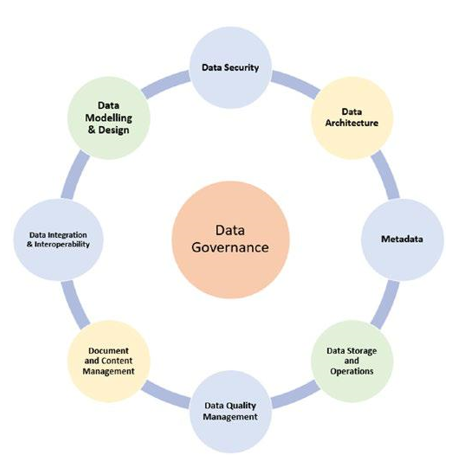
Step to Create Data Strategy 2 – Business Intelligence
6. Develop Recommendations: After developing vision and goals, the next steps are to provide recommendations based on the current state, and on the vision and goals for the future. The comprehensive solution and recommendations can be from people, process, and technology prospectives.
Figure 7-12 demonstrates technical levers to govern data management, like data architecture, metadata, data storage and operation, data quality, document and content management, data integration and interoperability, data modeling, and data security.

Figure 7-12. Technical levers
Reference and Master Data: This requires enabling of sharing information assets across multiple domains across the organization. Master data is defined as being reconciled, verified, quality, and source of truth. Implement standards through data models and data integration (DI) patterns.
Document and Content Management: As the organization grows, systems are complicated and documents grow in number. Managing content and documents is one of the goals. However, one of the many challenges is to only comply with existing country and international legal obligations. Goals are to ensure that systems and data are compliant. A second goal is to ensure storage, processing, and usage are safe; third, to have interoperability capability between unstructured content of documents with structured content.
Data governance strategy: The goal of the data governance strategy is to define the scope and approach to governance efforts. It should be implemented iteratively as the pieces are developed and approved. The deliverables include governance framework and accountabilities, and implementation roadmap for tools, technologies, processes, policies, and standardization to increase maturity.
Data warehouse and business intelligence: The goal of this lever is to plan, implement, and control processes to provide decision support data and to support knowledge workers engaged in reporting, query, and analysis.
Data storage and operation strategy: This technical lever’s goal is to design, develop, and support the storage of data. Another goal is to make sure data is available throughout the organization 24×7, manage data lifecycle, and manage the integrity and performance of data assets.
Data modeling and design: The goal of the data modeling management strategy is to design, document, and communicate an understanding of different perspectives, which leads to data management that more closely aligns with current and future business strategy, and create value through forming a data structure of data designed for integrity, capture, and retrieval of datasets.
Data architecture: The goal of data architecture is to identify data storage and processing needs of the enterprise. This is done by designing data structures and plans to meet the current and long-term data strategy of the enterprise. Data architecture strategy needs to align with business strategy. One of the goals of the organization is to prepare to quickly evolve their products, services, and data to take business advantages.
Data security: The goal of data security is to make sure that the right user has access to the right and secure data from the right system at the right point in time. It protects data to comply with all policies, procedures, privacy, and regulations to protect confidentiality, integrity, and privacy of all stakeholders.
Metadata: Metadata is the data about data. Metadata is prevalent in all applications. Usage of metadata in organizations requires standardization of the business terminology, access, and measure of the usage of applications across all domains. The usage of metadata is widespread for multiple use cases that ensures security and quality of data.
Data integration and interoperability: The goal is to make sure that data can flow through the systems connected with each other. Data can be pulled directly from another system or pushed to systems directly; e.g., sharing of metadata through trigger alerts, events, and actions.
Archives
- August 2024
- July 2024
- June 2024
- May 2024
- April 2024
- March 2024
- February 2024
- January 2024
- December 2023
- October 2023
- September 2023
- August 2023
- July 2023
- May 2023
- March 2023
- January 2023
- December 2022
- November 2022
- August 2022
- June 2022
- April 2022
- March 2022
- January 2022
- December 2021
- October 2021
- August 2021
- June 2021
- April 2021
- March 2021
- January 2021

Leave a Reply